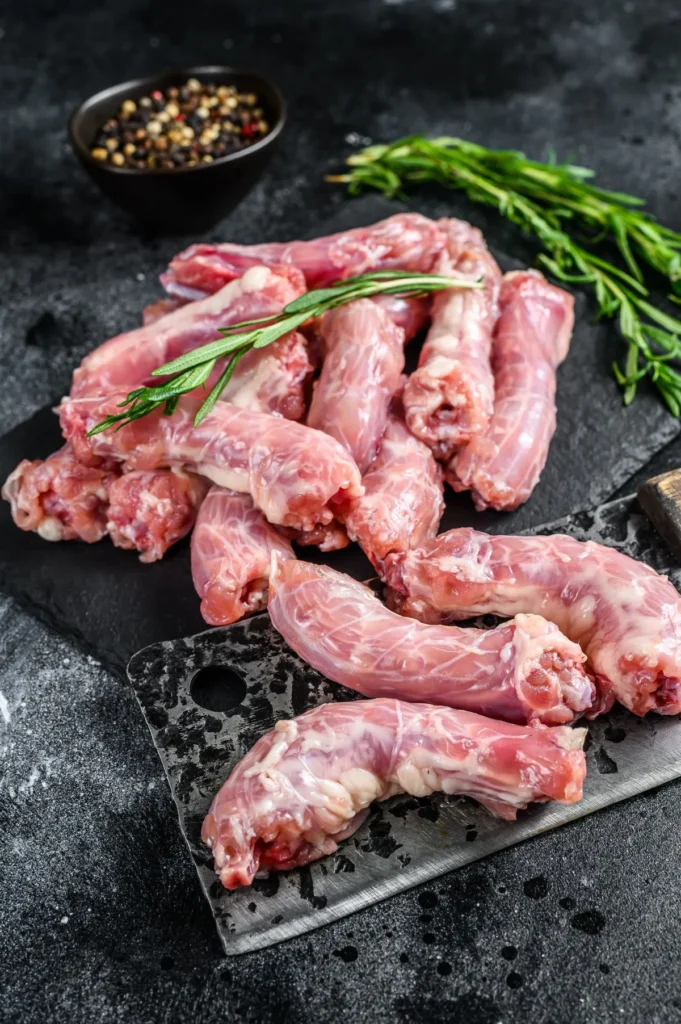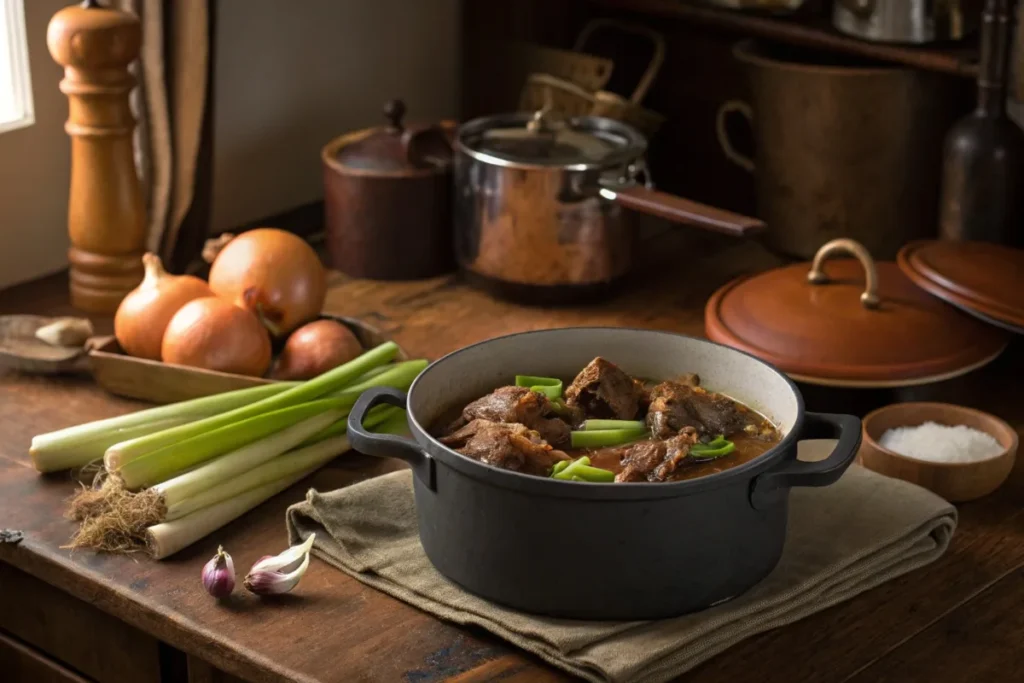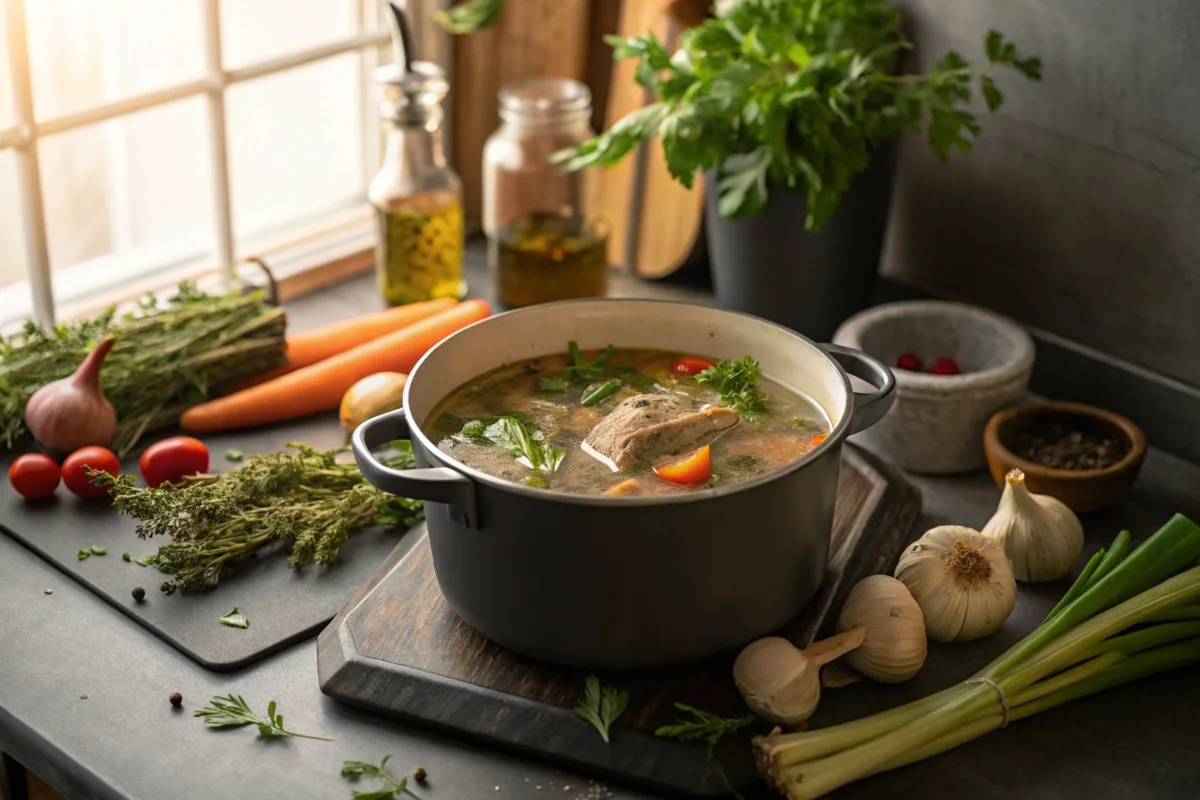What should I do with the turkey neck? Discover creative, safe, and delicious ways to use it for rich dishes, stocks, and festive meals.
Introduction
When you prepare a whole turkey, there is one part that often ends up overlooked: the turkey neck. Many people simply discard it without a second thought. However, this underappreciated piece of poultry has so much potential. In fact, it is a secret weapon that can help you create deeper, more complex flavors in your meals. When treated properly, the turkey neck can become the base of savory broths, melt-in-your-mouth slow-cooked dishes, and comforting soups that warm the soul.
Furthermore, understanding what to do with the turkey neck is a simple yet effective way to practice more sustainable cooking. By using the entire bird, you reduce food waste and honor the effort that went into raising it. In addition, adding turkey necks to your cooking routine can transform your dishes, delivering richness and intensity that you might not achieve from more familiar cuts.
In this article, we will explore everything about the turkey neck, from what it is and how it contributes to flavor, to the safest ways to handle and cook it. We will discuss different culinary uses, share traditional recipes, and provide tips for making it tender and mouthwatering. You will learn how to incorporate it into dishes from various cuisines and how to highlight its unique qualities. By the end, you will feel confident in turning this often-ignored piece of poultry into star-worthy meals that delight your family and guests.
Table of Contents
Understanding the Turkey Neck
The Anatomy and Flavor Profile
The turkey neck is a long, bony piece of poultry that connects the head to the body. Although it might not look like much, it contains a surprising amount of flavor. Inside the turkey neck, you will find connective tissues, a modest amount of lean meat, and a wealth of collagen. When cooked slowly and gently, this collagen breaks down, resulting in tender meat and a silky texture.
Moreover, turkey necks have a deep, savory flavor that enriches broths and stocks. For example, when you simmer a turkey neck with a few simple aromatics, you create a liquid base that tastes fuller and richer than a basic vegetable broth. Furthermore, the mild flavor of the turkey neck pairs well with many seasonings, allowing you to adapt it to a variety of cuisines.
Cultural and Historical Significance
In many traditional cuisines, the neck of a bird is never wasted. For instance, in Southern-style cooking, turkey necks are often included in slow-simmered dishes that feed the family on cold evenings. Likewise, many classic gravies, soups, and stews rely on the complexity that turkey necks contribute. Therefore, by embracing this ingredient, you connect to a long tradition of resourceful and flavorful cooking.
Safety, Storage, and Preparation Basics

Selecting and Storing Your Turkey Neck
Before you start cooking, you need to ensure the quality of your turkey neck. If you buy a whole bird, the neck usually comes tucked inside the cavity. Otherwise, you can purchase turkey necks at your local butcher or grocery store. Always choose turkey necks that are fresh or have been properly frozen. Additionally, look for necks that are plump and have a fresh, clean smell.
When storing, keep raw turkey necks in the refrigerator and use them within a day or two. If you need more time, wrap them tightly and freeze them, using them within a few months for the best quality. To safely thaw, transfer them from the freezer to the refrigerator and allow them to defrost overnight. This slow thawing process helps maintain texture and flavor.
Cleaning and Handling
Before cooking, rinse the turkey neck under cold, running water and pat it dry. You may need to trim away any excess skin or visible fat, although leaving some skin can add richness to stocks. After handling raw poultry, always wash your hands, cutting boards, and utensils with hot, soapy water to prevent cross-contamination.
Ensuring Food Safety
Turkey necks, like all raw poultry, must be handled with care. Therefore, follow basic food safety guidelines:
- Keep raw turkey separated from other foods.
- Cook thoroughly, reaching a safe internal temperature of 165°F (74°C).
- Promptly refrigerate leftovers and reheat them properly.
Culinary Uses for Turkey Necks
Rich Stocks and Flavorful Broths
One of the most common ways to use turkey necks is to transform them into homemade stock. Add a turkey neck to a pot with onions, celery, carrots, and a few herbs. Then cover it with water and let it simmer for several hours. As it cooks, the connective tissues release gelatin, giving your broth a silky body. Furthermore, this stock can serve as a foundation for soups, gravies, and sauces that deliver more depth than store-bought options.
Braised and Slow-Cooked Dishes
Because the turkey neck contains lean meat and connective tissue, low and slow cooking methods are ideal. For example, you can braise turkey necks in a pot with aromatic vegetables and a flavorful liquid. Over time, the meat becomes tender and easy to pull apart. This approach also allows you to infuse the dish with spices, herbs, and seasonings that highlight the turkey’s savory nature.
Gravies, Sauces, and Pan Drippings
If you roast a whole turkey, do not forget the neck. Placing the neck underneath or around the bird can enrich the pan drippings. After roasting, you can simmer these drippings with the neck to intensify the gravy. By doing so, you maximize flavor and make the most of the entire bird.
Hearty Soups and Stews
Turkey necks work perfectly in comfort foods like gumbo, barley soup, or rustic vegetable stews. Adding a turkey neck into the pot at the start of cooking allows the collagen-rich tissues to break down. As a result, you end up with a hearty soup that feels more satisfying. Moreover, once cooked, you can shred or pick the meat from the neck and incorporate it back into the dish.
Global Inspirations
Many cuisines have their own takes on poultry necks. For instance, you can cook turkey necks in a curry sauce or stew them with Mediterranean spices. Additionally, in Latin American-inspired dishes, you can simmer turkey necks with cilantro, tomatoes, and chiles for a robust, comforting meal. Likewise, these techniques transform the turkey neck into a versatile ingredient that adapts to various culinary traditions.
Traditional Recipes and Regional Specialties

Southern-Style Smothered Turkey Necks
A classic Southern dish involves braising turkey necks with onions, bell peppers, celery, and spices until the meat is fork-tender. The resulting meal pairs beautifully with cooked greens and a side of cornbread. Thus, you get a comforting meal that is both simple and full of character.
Cajun and Creole Influences
In Louisiana cuisine, turkey necks often appear in gumbos and flavorful stews. By incorporating turkey necks, you create layers of taste that define Creole cooking. Furthermore, the slow simmer helps extract maximum flavor from the neck, blending it seamlessly into the broth. This approach results in rich, complex dishes that showcase the art of careful seasoning and patient cooking.
Soul Food Preparations
In soul food traditions, turkey necks are often cooked with leafy greens and legumes, creating nutrient-dense, warming meals. For example, braising turkey necks with collard greens and a hint of spice can elevate a simple weeknight dinner into something special. In addition, the natural flavors of the turkey neck help bring out the best in the vegetables.
Holiday and Festive Meals
During the holidays, you can use the turkey neck to prepare a flavorful base for your Thanksgiving gravy. Instead of discarding it, simmer it with vegetables and seasonings. By the time the turkey is out of the oven, you will have a pot of rich stock ready to transform into an unforgettable gravy. Thus, it is a small step that makes a big difference in your holiday feast.
Health and Nutritional Considerations
Nutritional Profile
Turkey necks provide a good source of protein and essential minerals. They also contain collagen, which contributes to the texture and mouthfeel of broths and braised dishes. Although turkey necks have some fat, it is usually moderate. Balancing them with vegetables can help create a meal that is both satisfying and healthful.
Dietary Restrictions and Substitutions
If you follow a Paleo or low-carb diet, turkey necks can fit nicely into your meal plans. They add depth to your menu and can serve as a flavorful alternative to more common poultry parts. For those needing substitutes, chicken necks or even turkey wings can yield somewhat similar results, though flavor and texture may vary.
Tips, Techniques, and Flavor Enhancements
Marinating and Brining
To ensure that the turkey necks turn out tender and tasty, consider marinating them in an acidic solution, such as a mixture of lemon juice and herbs. Additionally, a simple brine of water, salt, and spices can help season the meat from the inside out, making the final dish more savory and appealing.
Seasoning Suggestions
Common aromatics include onions, celery, carrots, and garlic. As for herbs, thyme and rosemary can work well. You can also add spices like paprika or cayenne for heat. In addition, consider adding a bay leaf or a small amount of dried herbs to build depth.
Cooking Times and Techniques
When braising or slow-cooking turkey necks, give them enough time to soften. This process might take a couple of hours on a low simmer. It may seem long, but it ensures the necks become tender. If you want to speed things up, try using a pressure cooker to cut down on cooking time while still achieving a tender result.
Sustainability and Ethical Considerations
By using the turkey neck, you support a “nose-to-tail” approach. In other words, you reduce waste by making the most of the entire animal. Furthermore, consider choosing turkey from local farms that emphasize humane practices. This choice allows you to enjoy your meals knowing they come from a more responsible source.
Serving and Presentation Ideas
When serving turkey neck dishes, try to present them in a way that highlights their comforting qualities. For example, serve braised turkey necks in a shallow bowl with bright, fresh herbs sprinkled on top. Offer a side of mashed potatoes or roasted vegetables for a balanced meal. Although turkey necks are often part of a larger dish, they can still star on their own plate when arranged thoughtfully.
Recipe: Braised Turkey Necks with Vegetables
This simple recipe highlights the rich flavor and tender texture of turkey necks. The slow braise ensures the meat becomes succulent, while the vegetables and seasonings develop a comforting, home-style meal.
Ingredients
- 2 turkey necks (about 1 lb total)
- 1 tablespoon cooking oil
- 1 medium onion, chopped
- 1 celery stalk, chopped
- 1 carrot, chopped
- 2 cloves garlic, minced
- 1 teaspoon dried thyme
- 1 bay leaf
- 4 cups low-sodium turkey or chicken broth
- Salt and black pepper to taste
- Fresh parsley, chopped (for garnish)
Instructions
- Prepare the Neck:
Rinse the turkey necks under cold water and pat dry. Season with salt and pepper. - Sear the Neck:
In a large pot over medium-high heat, add the oil. Once hot, add the turkey necks and sear on all sides until lightly browned. This step creates a richer flavor base. Remove the necks and set aside. - Sauté Aromatics:
Reduce the heat to medium. Add the onion, celery, and carrot to the pot. Sauté until the onion is translucent, about 5 minutes. Stir in the garlic, dried thyme, and bay leaf. - Add the Liquid:
Return the turkey necks to the pot. Pour in the broth, ensuring the necks are mostly covered. Bring the mixture to a gentle simmer. - Simmer Slowly:
Cover the pot and reduce the heat to low. Let it simmer for about 2 hours, or until the turkey neck meat is very tender and can be easily pulled apart with a fork. Check occasionally and adjust the seasoning with salt and pepper. - Finish and Serve:
Once done, discard the bay leaf. Taste and adjust seasonings if needed. Serve in a shallow bowl, sprinkled with fresh parsley. Consider pairing with a side of mashed potatoes or steamed greens.
Check out our turkey necks recipe.
Nutritional Information (Per 100g)
| Nutrient | Amount |
|---|---|
| Calories | 150 kcal |
| Protein | 20 g |
| Fat | 6 g |
| Carbohydrates | 2 g |
| Fiber | 0 g |
| Sodium | 60 mg |
| Iron | 1.5 mg |
(Values are approximate and may vary based on ingredients used.)
Frequently Asked Questions
How do you get rid of turkey neck fast?
If you mean the actual piece of meat known as the turkey neck, you can incorporate it into your meal right away by making a stock, gravy, or stew. However, if you are referring to the loose skin under the chin sometimes called “turkey neck” in human terms, that is unrelated to cooking turkey necks. For cooking, simply remove it from the cavity of your turkey and use it in a recipe.
Are you supposed to remove turkey neck?
Yes, you typically remove the turkey neck from the turkey cavity before cooking the whole bird. Most people discard it, but you should keep it. The turkey neck can be used to create a flavorful broth or gravy, ensuring you use the whole bird.
What is turkey neck meat good for?
Turkey neck meat is ideal for adding flavor and body to stocks, gravies, and soups. When cooked low and slow, it becomes tender and imparts a deep, savory taste to many dishes. It is also a great option for traditional, comforting meals such as stews and braised dishes.
Can I use turkey necks if I do not have a whole bird?
Yes. Many butchers or grocery stores sell turkey necks separately. You can buy just the necks and use them in your desired recipe. This option works well if you want to focus on making stock or a particular dish without purchasing a whole turkey.
Can I substitute turkey necks with other poultry necks?
You can often substitute turkey necks with chicken necks or duck necks in recipes. The flavor will vary slightly, but the cooking process remains similar. Adjust the seasonings and cooking time to get the best results.
Conclusion
The turkey neck, once overlooked, is truly a hidden gem in the culinary world. By learning how to handle, cook, and season it, you unlock flavors that elevate your everyday meals. Furthermore, using the entire bird supports sustainable cooking and reduces waste. Whether you braise it slowly to serve with vegetables or simmer it into a rich broth for soups and gravies, the turkey neck offers unique depth and character.
In addition, experimenting with turkey necks encourages you to embrace traditional cooking methods and adapt them to your own style. With a little patience and the right combination of ingredients, you can transform this humble piece of poultry into a dish that warms both body and soul.

